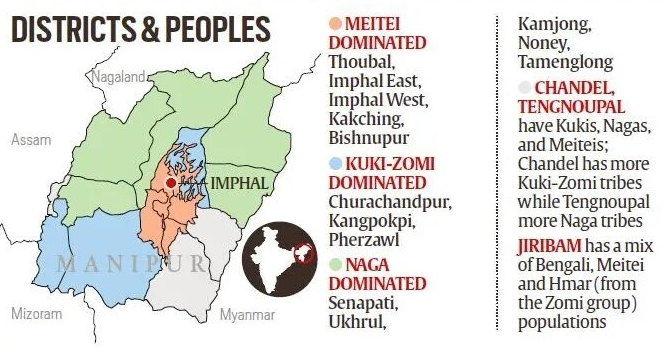Syllabus: GS3/Internal Security
Context
- The ongoing Manipur crisis which has lasted for two years, has resulted in over deaths and the displacement that has not received the same level of national priority as other security concerns.
About the Manipur Issue
- It escalated in May 2023, stemming from ethnic tensions between the Meitei and tribal communities, particularly the Kuki-Zo groups.
- It was triggered by the Manipur High Court’s directive to consider granting Scheduled Tribe (ST) status to the Meitei community, which led to widespread protests and violence.
| Manipur – Historically, Manipur has been a center for Krishna consciousness, with its rulers embracing Vaishnavism since the 15th century. – It shares border with: 1. Nagaland (204Km) in the north 2. Mizoram (95Km) in the south 3. Assam (204.1Km) in the west – International Borders: Myanmar (352Km) in the east as well as in the south. – It is known for its classical dance form, Manipuri.It is often referred to as the gateway to Southeast Asia, given its geographical location and proximity to Myanmar. – It is a crucial part of India’s Act East Policy, aimed at strengthening trade and diplomatic ties with Southeast Asia. |
Background of the Conflict
- Demographic & Political Imbalance: The Imphal Valley makes up 10% of the state’s landmass, is dominated by the Meitei community, who constitute over 64% of the population and hold a majority of seats in the state assembly.
- Other regions, except the Imphal Valley, comprising 90% of the land, are home to various tribal groups, including the Kuki and Naga communities, have less representation in state assembly.
- Immediate Reason: In April 2023, the High Court of Manipur directed the state government to submit a 10-year-old recommendation for Meitei ST status to the Union Tribal Affairs Ministry.
- It was opposed by the tribal groups, arguing that the Meiteis already hold political and economic advantages and that granting them ST status would further marginalize tribal communities.

Key Concerns
- Humanitarian Crisis: Over 250 deaths and thousands displaced in relief camps.
- Lack of basic necessities, healthcare, and education for affected communities.
- The buffer zone, meant to separate communities, has instead become a flashpoint for further violence.
- Political Instability: The imposition of President’s Rule following the resignation of the Chief Minister.
- Lack of clear roadmap for reconciliation.
- Thousands of Kuki-Zo residents gathered to observe ‘Separation Day’, demanding a separate administrative arrangement, in Churachandpur.
- Ethnic Tensions and Security Concerns: Deep-rooted Meitei vs. Kuki-Zo divisions, exacerbated by political narratives.
- Attempts to frame the violence as a cross-border security threat, particularly blaming Kuki armed militants from Myanmar.
- The mobilization of valley-based insurgent groups (VBIGs), which has received little attention.
- Economic Impact: Internet shutdowns, leading to restricted communication and documentation of the crisis.
- Inflation and rising food prices, making survival even more difficult for displaced communities.
- Decline in tourism and small-scale industries, affecting the state’s economy.
- Challenges to India’s Act East Policy: The unrest in Manipur could impact India’s Act East Policy, which aims to boost economic and strategic ties with Southeast Asia.
Way Forward: Dialogue & Reconciliation
- Political Leadership and Governance Reforms: The Union government needs to actively engage with all stakeholders to ensure a neutral and effective administration.
- The Manipur People’s Convention urged the central government to ensure free and safe movement for all residents and called for a time-bound roadmap to restore peace.
- Community-led peace initiatives should be encouraged to rebuild trust and social cohesion.
- Security and Law Enforcement: The buffer zone policy needs reassessment to prevent further violence.
- Illegal weapons circulation must be curtailed to prevent armed conflicts.
- Security forces should focus on de-escalation rather than militarization of the region.
- Inclusive dialogue: Engage all stakeholders, including various ethnic groups, in a dialogue to understand their grievances and find common ground.
- The Mizoram Accord of 1986 between the Government of India and the Mizo National Front (MNF) serves as an example of successful engagement with all stakeholders.
- Evaluation of Criteria for declaring a community as SC/ST: The Lokur Committee (1965) which recommended criteria for identification, namely, primitive traits, distinct culture, geographical isolation, shyness of contact with the community at large, and backwardness.
- Humanitarian Relief and Economic Recovery: Immediate relief measures need to be expanded to support displaced individuals.
- Economic rehabilitation programs should be introduced to restore livelihoods.
- Infrastructure rebuilding is essential to ensure long-term stability.
| Daily Mains Practice Question [Q] Does the Indian government’s handling of the Manipur issue reflect a deeper paradox in its approach to internal conflicts — one that prioritizes political and security concerns over the humanitarian crisis? |
Previous article
Road to Safety: Navigating India’s Mobility Transformation